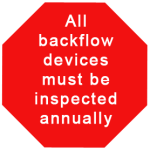- Written by water

Accurate backflow testing and reporting is one of the more important safeguards in any city, one which assures all citizens that they will be drinking clean, healthy water. This article will discuss the process of backflow testing by a backflow tester and what it means for all of us. If you have questions, feel free to call us at (817) 996-2000 and we will try our best to answer them.
What is backflow?
To understand the importance of accurate backflow testing, one must first have a rudimentary understanding of backflow and the dangers it represents.
Water systems in the United States work using water pressure. Water is “pushed” through pipes, from a city’s potable water supply, to homes and businesses using water pressure created by pumps. This basic process has worked this way, across the country, for decades, and it is approximately 95% safe and sound when applied correctly. It is, however, the remaining 5% of the times when citizens need to be concerned.
All works well in the water supply system as long as the water pressure is steady. What happens, however, if there is a sudden drop in the water pressure? What happens if there is a burst water main, or if several fire hydrants are opened up at once to fight a major fire? What happens is this: the water pressure to the city will drop, and if it drops too low it is entirely possible for water within the system to reverse flow . . .to backflow . . . so that contaminated water from homes and businesses would then be flowing back towards the city’s potable water supply.
Obviously this would be a major health hazard, and was a major health hazard, until someone invented backflow preventers which stop water from flowing in the opposite direction, and those backflow devices need to be checked yearly to make sure they are working properly and giving accurate backflow protection.
Backflow testing
Backflow testing is required in all commercial properties in any city, as well as those which have fire sprinkler systems and some with irrigation systems. Most of the time, individual residential homes do not require a backflow device. This testing is required annually, and it is required that it be conducted by a licensed and state certified backflow tester. In addition, test results must be filed with the city’s water department.
Backflow Installation and Repairs
When new backflow devices are installed, their installation must be filed with the city, and if any backflow repairs are done, that information must also be reported to the proper officials. Only city approved backflow parts can be used for any repairs or installations.
If all of these steps are taken, and if all of the backflow procedures are followed, the danger of backflow is eliminated. To find out if you are required to be a part of the backflow inspections, call your local water department, and you can also call them for a list of approved backflow testers in your city.
Questions? You can call us and we will do our best to answer them. We are City Backflow Testing, serving the Greater Fort Worth, Texas, area.
Posted in Backflow Testing

